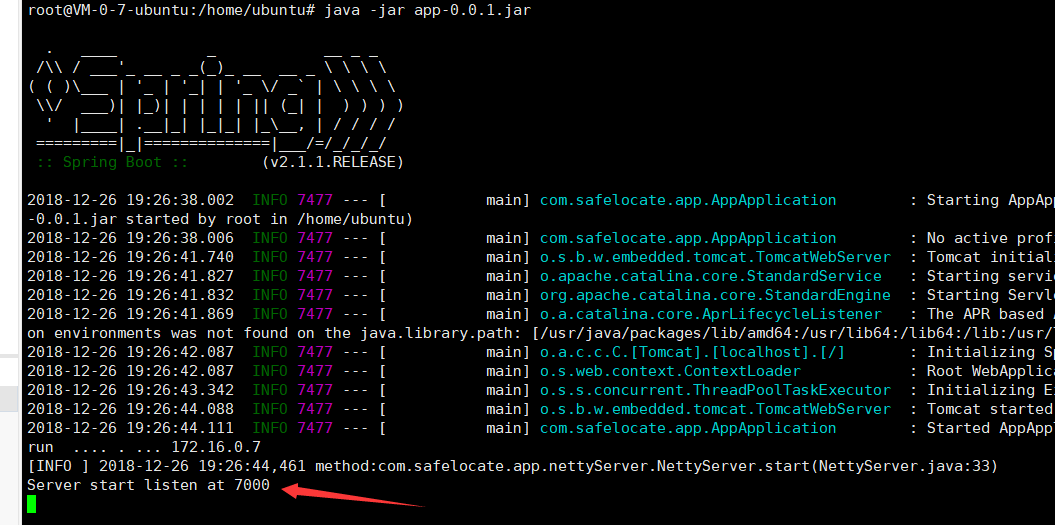前言
Netty 是一个高性能的 NIO 网络框架,本文主要给大家介绍了关于SpringBoot集成netty实现客户端服务端交互的相关内容,下面来一起看看详细的介绍吧
看了好几天的netty实战,慢慢摸索,虽然还没有摸着很多门道,但今天还是把之前想加入到项目里的
一些想法实现了,算是有点信心了吧(讲真netty对初学者还真的不是很友好......)
首先,当然是在SpringBoot项目里添加netty的依赖了,注意不要用netty5的依赖,因为已经废弃了
<!--netty--> <dependency> <groupId>io.netty</groupId> <artifactId>netty-all</artifactId> <version>4.1.32.Final</version> </dependency>
将端口和IP写入application.yml文件里,我这里是我云服务器的内网IP,如果是本机测试,用127.0.0.1就ok
netty: port: 7000 url: 172.16.0.7
在这之后,开始写netty的服务器,这里服务端的逻辑就是将客户端发来的信息返回回去
因为采用依赖注入的方法实例化netty,所以加上@Component注释
package com.safelocate.app.nettyServer;
import io.netty.bootstrap.ServerBootstrap;
import io.netty.channel.*;
import io.netty.channel.nio.NioEventLoopGroup;
import io.netty.channel.socket.nio.NioServerSocketChannel;
import org.apache.log4j.Logger;
import org.springframework.stereotype.Component;
import java.net.InetSocketAddress;
@Component
public class NettyServer {
//logger
private static final Logger logger = Logger.getLogger(NettyServer.class);
public void start(InetSocketAddress address){
EventLoopGroup bossGroup = new NioEventLoopGroup(1);
EventLoopGroup workerGroup = new NioEventLoopGroup();
try {
ServerBootstrap bootstrap = new ServerBootstrap()
.group(bossGroup,workerGroup)
.channel(NioServerSocketChannel.class)
.localAddress(address)
.childHandler(new ServerChannelInitializer())
.option(ChannelOption.SO_BACKLOG, 128)
.childOption(ChannelOption.SO_KEEPALIVE, true);
// 绑定端口,开始接收进来的连接
ChannelFuture future = bootstrap.bind(address).sync();
logger.info("Server start listen at " + address.getPort());
future.channel().closeFuture().sync();
} catch (Exception e) {
e.printStackTrace();
bossGroup.shutdownGracefully();
workerGroup.shutdownGracefully();
}
}
}
当然,这里的ServerChannelInitializer是我自己定义的类,这个类是继承ChannelInitializer<SocketChannel>的,里面设置出站和入站的编码器和解码器
package com.safelocate.app.nettyServer;
import io.netty.channel.ChannelInitializer;
import io.netty.channel.socket.SocketChannel;
import io.netty.handler.codec.string.StringDecoder;
import io.netty.handler.codec.string.StringEncoder;
import io.netty.util.CharsetUtil;
public class ServerChannelInitializer extends ChannelInitializer<SocketChannel> {
@Override
protected void initChannel(SocketChannel channel) throws Exception {
channel.pipeline().addLast("decoder",new StringDecoder(CharsetUtil.UTF_8));
channel.pipeline().addLast("encoder",new StringEncoder(CharsetUtil.UTF_8));
channel.pipeline().addLast(new ServerHandler());
}
}
最好注意被别decoder和encoder写成了一样的,不然会出问题(我之前就是不小心都写成了StringDecoder...)
在这之后就是设置ServerHandler来处理一些简单的逻辑了
package com.safelocate.app.nettyServer;
import io.netty.channel.ChannelHandlerContext;
import io.netty.channel.ChannelInboundHandlerAdapter;
import io.netty.channel.SimpleChannelInboundHandler;
import java.io.IOException;
import java.io.OutputStream;
import java.io.PrintWriter;
import java.net.InetAddress;
import java.net.Socket;
public class ServerHandler extends ChannelInboundHandlerAdapter {
@Override
public void channelActive(ChannelHandlerContext ctx) {
System.out.println("channelActive----->");
}
@Override
public void channelRead(ChannelHandlerContext ctx, Object msg) throws Exception {
System.out.println("server channelRead......");
System.out.println(ctx.channel().remoteAddress()+"----->Server :"+ msg.toString());
//将客户端的信息直接返回写入ctx
ctx.write("server say :"+msg);
//刷新缓存区
ctx.flush();
}
@Override
public void exceptionCaught(ChannelHandlerContext ctx, Throwable cause) throws Exception {
cause.printStackTrace();
ctx.close();
}
}
准备工作到这里,现在要做到就是去启动这个程序
将AppApplication实现CommandLineRunner这个接口,这个接口可以用来再启动SpringBoot时同时启动其他功能,比如配置,数据库连接等等
然后重写run方法,在run方法里启动netty服务器,Server类用@AutoWired直接实例化
package com.safelocate.app;
import com.safelocate.app.nettyServer.NettyServer;
import io.netty.channel.ChannelFuture;
import org.springframework.beans.factory.annotation.Autowired;
import org.springframework.beans.factory.annotation.Value;
import org.springframework.boot.CommandLineRunner;
import org.springframework.boot.SpringApplication;
import org.springframework.boot.autoconfigure.SpringBootApplication;
import java.net.InetAddress;
import java.net.InetSocketAddress;
@SpringBootApplication
public class AppApplication implements CommandLineRunner {
@Value("${netty.port}")
private int port;
@Value("${netty.url}")
private String url;
@Autowired
private NettyServer server;
public static void main(String[] args) {
SpringApplication.run(AppApplication.class, args);
}
@Override
public void run(String... args) throws Exception {
InetSocketAddress address = new InetSocketAddress(url,port);
System.out.println("run .... . ... "+url);
server.start(address);
}
}
ok,到这里服务端已经写完,本地我也已经测试完,现在需要打包部署服务器,当然这个程序只为练手...
控制台输入mvn clean package -D skipTests 然后将jar包上传服务器,在这之后,需要在腾讯云/阿里云那边配置好安全组,将之前yml文件里设定的端口的入站
规则设置好,不然访问会被拒绝
之后java -jar命令运行,如果需保持后台一直运行 就用nohup命令,可以看到程序已经跑起来了,等待客户端连接交互

之后就是写客户端了,客户端其实是依葫芦画瓢,跟上面类似
Handler
package client;
import io.netty.channel.ChannelHandlerContext;
import io.netty.channel.ChannelInboundHandlerAdapter;
public class ClientHandler extends ChannelInboundHandlerAdapter {
@Override
public void channelActive(ChannelHandlerContext ctx) {
System.out.println("ClientHandler Active");
}
@Override
public void channelRead(ChannelHandlerContext ctx, Object msg) {
System.out.println("--------");
System.out.println("ClientHandler read Message:"+msg);
}
@Override
public void exceptionCaught(ChannelHandlerContext ctx, Throwable cause) {
cause.printStackTrace();
ctx.close();
}
}
ChannelInitializer
package client;
import io.netty.channel.ChannelInitializer;
import io.netty.channel.ChannelPipeline;
import io.netty.channel.socket.SocketChannel;
import io.netty.handler.codec.string.StringDecoder;
import io.netty.handler.codec.string.StringEncoder;
import io.netty.util.CharsetUtil;
public class ClientChannelInitializer extends ChannelInitializer<SocketChannel> {
protected void initChannel(SocketChannel channel) throws Exception {
ChannelPipeline p = channel.pipeline();
p.addLast("decoder", new StringDecoder(CharsetUtil.UTF_8));
p.addLast("encoder", new StringEncoder(CharsetUtil.UTF_8));
p.addLast(new ClientHandler());
}
}
主函数所在类,即客户端
package client;
import io.netty.bootstrap.Bootstrap;
import io.netty.channel.*;
import io.netty.channel.nio.NioEventLoopGroup;
import io.netty.channel.socket.SocketChannel;
import io.netty.channel.socket.nio.NioSocketChannel;
import io.netty.handler.codec.string.StringDecoder;
import io.netty.handler.codec.string.StringEncoder;
public class Client {
static final String HOST = System.getProperty("host", "服务器的IP地址");
static final int PORT = Integer.parseInt(System.getProperty("port", "7000"));
static final int SIZE = Integer.parseInt(System.getProperty("size", "256"));
public static void main(String[] args) throws Exception {
sendMessage("hhhh");
}
public static void sendMessage(String content) throws InterruptedException{
// Configure the client.
EventLoopGroup group = new NioEventLoopGroup();
try {
Bootstrap b = new Bootstrap();
b.group(group)
.channel(NioSocketChannel.class)
.option(ChannelOption.TCP_NODELAY, true)
.handler(new ChannelInitializer<SocketChannel>() {
@Override
public void initChannel(SocketChannel ch) throws Exception {
ChannelPipeline p = ch.pipeline();
p.addLast("decoder", new StringDecoder());
p.addLast("encoder", new StringEncoder());
p.addLast(new ClientHandler());
}
});
ChannelFuture future = b.connect(HOST, PORT).sync();
future.channel().writeAndFlush(content);
future.channel().closeFuture().sync();
} finally {
group.shutdownGracefully();
}
}
}
启动客户端,这里就是简单发送一条"hhhh",可以看到客户端已经收到服务器发来的信息
 |
然后再看服务端,也有相应的信息打印

总结
以上就是这篇文章的全部内容了,希望本文的内容对大家的学习或者工作具有一定的参考学习价值,如果有疑问大家可以留言交流,谢谢大家对的支持。